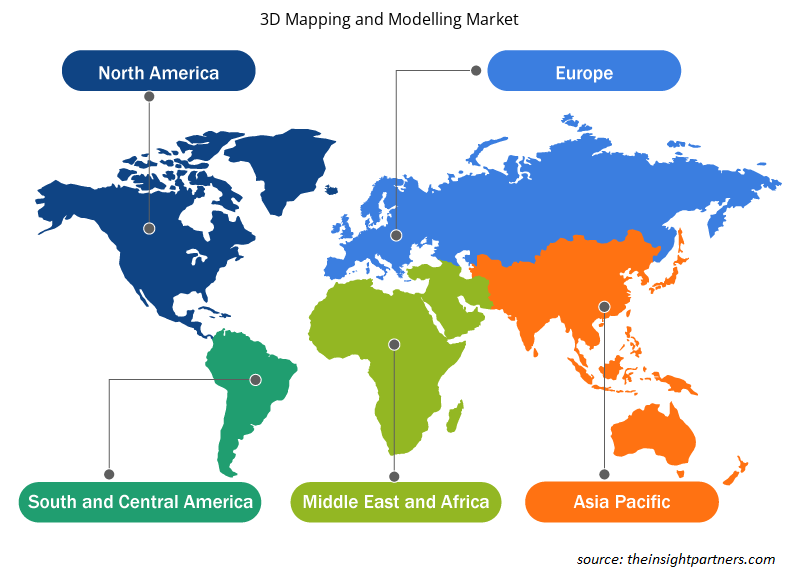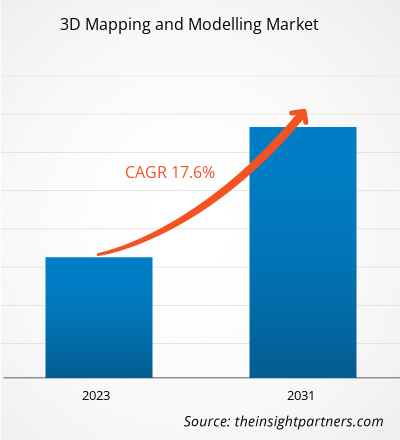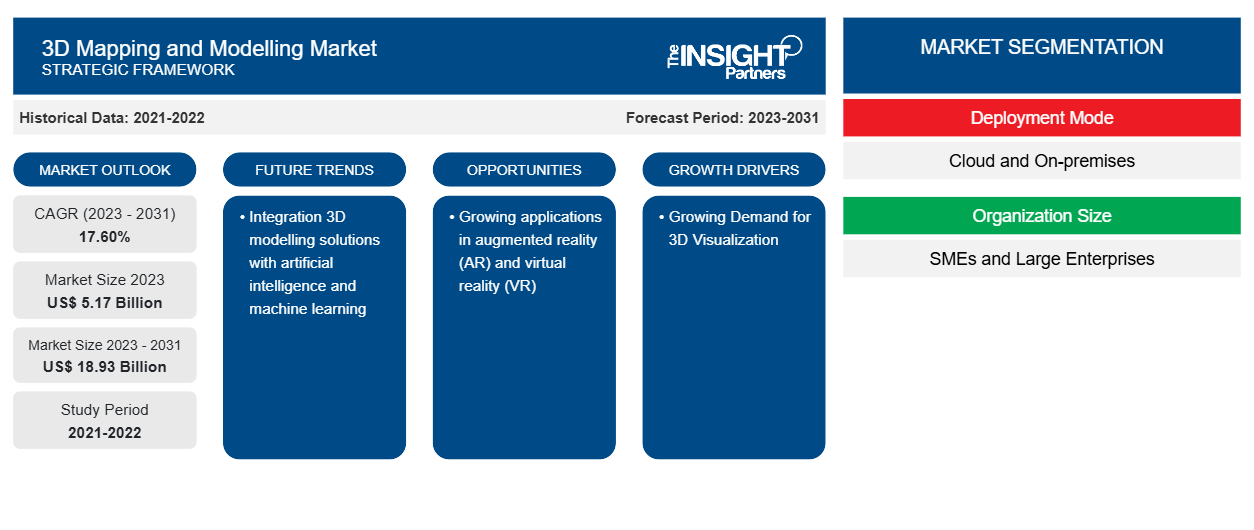3D 测绘和建模市场规模预计将从 2023 年的 51.7 亿美元增至 2031 年的 189.3 亿美元。预计 2023-2031 年期间该市场的复合年增长率将达到 17.60%。3D 建模解决方案与人工智能和机器学习的结合很可能仍是市场的主要趋势。
3D 地图和建模市场分析
3D 动画需求的不断增长、3D 扫描设备的技术发展、3D 内容需求的激增以及 3D 显示设备的增加是推动全球 3D 测绘和建模市场发展的一些主要驱动因素。此外,人工智能和机器学习等技术在 3D 测绘和建模软件中的使用和集成越来越多,以提高 3D 内容的准确性,从而推动了市场扩张。预计所有这些原因将在整个预测期内为市场参与者提供足够的发展机会。
3D 地图和建模市场概览
3D 地图和建模平台使用户能够创建项目和位置的基本三维模型和地图。这些技术还有助于地理/位置数据的可视化、查询、分析和解释,使用户能够掌握各种因素之间的联系、模式和趋势,以解决现实世界的业务挑战。全球企业和个人利用 3D 地图和建模技术来识别需要改变的问题区域和要素,以增强运营、提高效率并最大限度地利用资源。这些工具通常用于以土地为中心的业务,例如工程和建筑、制造、运输和物流以及许多其他现场服务管理、楼层管理、资产管理和库存管理应用。3D 工具还用于建筑/建筑和土木工程设计应用。激光雷达、声纳、雷达和摄影测量是一些最常见的 3D 地图技术,3D 建模可以包括线框、表面和实体建模。
定制此报告以满足您的需求
您可以免费定制任何报告,包括本报告的部分内容、国家级分析、Excel 数据包,以及为初创企业和大学提供优惠和折扣
-
获取此报告的关键市场趋势。这个免费样品将包括数据分析,从市场趋势到估计和预测。
3D 地图和建模市场驱动因素和机遇
3D 可视化需求不断增长,市场前景看好
多个行业对 3D 可视化的需求日益增长。电影中视觉效果技术 (VFX) 的使用、3D 移动应用和游戏的使用以及数字营销的兴起趋势都促进了 3D 地图和建模市场的增长。例如,游戏行业使用 3D 可视化通过 3D 游戏材料、角色和位置创造身临其境的体验。营销和零售行业使用 3D 可视化进行原型设计、为活动开发视觉效果以及改善消费者体验。此外,3D 可视化在医疗保健领域也是必不可少的,包括医学成像、手术规划和患者教育等应用。VFX) in films, the usage of 3D mobile apps and gaming, and the rising trend of digital marketing are all contributing to the growth of the 3D mapping and modelling market. For instance, the gaming business uses 3D visualization to create immersive experiences using 3D game materials, characters, and locations. The marketing and retail industries employ 3D visualization for prototyping, developing visuals for campaigns, and improving consumer experiences. Moreover, 3D visualization is essential in healthcare for applications including
增强现实 (AR) 和虚拟现实 (VR) 的应用日益增多
增强现实 (AR) 和虚拟现实 (VR) 技术正在迅速发展,并应用于各个领域。这些技术使用 3D 模型来创建沉浸式数字体验,从而改变用户与周围世界的互动方式。AR 通过将照片、视频和文本等数字组件整合到物理环境中来促进现实世界的发展。它使数字信息能够叠加在现实世界的事物上,从而改善我们对环境的感知和了解。另一方面,VR 通过将用户转移到数字创建的环境中来创造完全虚拟的体验。它开发了可用于教学、娱乐和其他目的的沉浸式模拟。
3D 地图和建模市场报告细分分析
有助于得出 3D 地图和建模市场分析的关键部分是部署模式、组织规模、组件、3D 地图应用、3D 建模应用和垂直。
- 根据部署模式,市场分为云和本地部署。2023 年,本地部署占据了市场份额的主导地位。
- 根据组织规模,市场分为中小型企业和大型企业。大型企业在 2023 年占据了最大的市场份额。
- 根据组件,市场分为软件工具和服务。软件工具部分在 2023 年占据了最大的市场份额。
- 根据 3D 地图应用,市场细分为检查和测量、对象重建、投影和导航、报告和虚拟化以及其他 3D 地图应用。检查和测量部分在 2023 年占据了最大的市场份额。
- 根据 3D 建模应用,市场细分为产品营销、动画和电影、游戏和设计、建筑渲染和其他 3D 建模应用。产品营销部门在 2023 年占据了最大的市场份额。
- 根据垂直行业,市场细分为零售和消费品、工程和建筑、医疗保健和生命科学、运输和物流、政府和国防、能源和公用事业、媒体和娱乐、制造业和其他垂直行业。工程和建筑行业在 2023 年占据了最大的市场份额。
3D 地图和建模市场份额(按地区)分析
3D 地图和建模市场报告的地理范围主要分为五个区域:北美、亚太、欧洲、中东和非洲、南美和中美。
2023 年,北美主导了 3D 测绘和建模市场。这种主导地位可以归因于该地区不断发展的技术驱动型公司生态系统。建筑、城市规划和无人驾驶汽车都受益于 3D 测绘和建模技术的使用。此外,北美是 3D 测绘和建模领域的主要公司的所在地,其中包括 Autodesk、Trimble, Inc. 和 Bentley Systems 等。这些公司的存在,加上他们的经验和资源,增强了该地区的市场优势。
3D 地图和建模市场区域洞察
Insight Partners 的分析师已详细解释了预测期内影响 3D 测绘和建模市场的区域趋势和因素。本节还讨论了北美、欧洲、亚太地区、中东和非洲以及南美和中美洲的 3D 测绘和建模市场细分和地理位置。

- 获取 3D 地图和建模市场的区域特定数据
3D 地图和建模市场报告范围
| 报告属性 | 细节 |
|---|---|
| 2023 年的市场规模 | 51.7亿美元 |
| 2031 年市场规模 | 189.3亿美元 |
| 全球复合年增长率(2023 - 2031) | 17.60% |
| 史料 | 2021-2022 |
| 预测期 | 2023-2031 |
| 涵盖的领域 |
按部署模式
|
| 覆盖地区和国家 |
北美
|
| 市场领导者和主要公司简介 |
|
市场参与者密度:了解其对商业动态的影响
3D 地图和建模市场正在快速增长,这得益于最终用户需求的不断增长,这些需求源于消费者偏好的不断变化、技术进步以及对产品优势的认识不断提高等因素。随着需求的增长,企业正在扩大其产品范围,进行创新以满足消费者的需求,并利用新兴趋势,从而进一步推动市场增长。
市场参与者密度是指在特定市场或行业内运营的企业或公司的分布情况。它表明相对于给定市场空间的规模或总市场价值,有多少竞争对手(市场参与者)存在于该市场空间中。
在 3D 地图和建模市场运营的主要公司有:
- 欧特克
- 萨博公司
- 黄金软件
- 天宝
- 宾利系统公司
- 字母
免责声明:上面列出的公司没有按照任何特定顺序排列。

- 获取 3D 地图和建模市场顶级关键参与者概览
3D 地图和建模市场新闻和最新发展
3D 地图和建模市场通过收集一手和二手研究后的定性和定量数据进行评估,其中包括重要的公司出版物、协会数据和数据库。以下列出了 3D 地图和建模市场的一些发展:
- Autodesk 宣布了 Bernini 项目。这项新研究工作提供了第一个实验性的生成式 AI 模型,该模型可以从各种输入中快速生成出色的 3D 形状,包括单个 2D 图像、显示对象不同视图的多幅图像、点云、体素和文本。Bernini 项目旨在创建可用于建筑、产品设计、娱乐等不同领域的生成模型,以生成可用于实际应用并符合设计师愿景的功能性 3D 结构。(来源:Autodesk,新闻稿,2024 年 5 月)
- Trimble 宣布推出 Trimble X9 3D 激光扫描系统,这是一款面向测量、建筑和工程专业人士的新型多功能现实捕捉解决方案。X9 基于 Trimble 久经考验的激光扫描技术,旨在提高更多环境下的性能,同时利用 Trimble X-Drive 技术等创新技术实现自动仪器校准、测量级自动调平和激光指示器进行地理参考。(来源:Trimble,新闻稿,2023 年 6 月)
3D 地图和建模市场报告覆盖范围和交付成果
“3D 地图和建模市场规模和预测(2021-2031 年)”报告对以下领域进行了详细的市场分析:
- 3D 地图和建模市场规模以及范围涵盖的所有关键细分市场的全球、区域和国家/地区预测
- 3D 地图和建模市场趋势以及市场动态,如驱动因素、限制因素和关键机遇
- 详细的 PEST/波特五力分析和 SWOT 分析
- 3D 地图和建模市场分析涵盖关键市场趋势、全球和区域框架、主要参与者、法规和最新市场发展
- 行业格局和竞争分析,涵盖市场集中度、热图分析、知名参与者以及 3D 地图和建模市场的最新发展
- 详细的公司简介
- 历史分析(2 年)、基准年、预测(7 年)及复合年增长率
- PEST和SWOT分析
- 市场规模、价值/数量 - 全球、区域、国家
- 行业和竞争格局
- Excel 数据集
近期报告
相关报告
客户评价
购买理由
- 明智的决策
- 了解市场动态
- 竞争分析
- 客户洞察
- 市场预测
- 风险规避
- 战略规划
- 投资论证
- 识别新兴市场
- 优化营销策略
- 提升运营效率
- 顺应监管趋势























 获取免费样品 - 3D地图和建模市场
获取免费样品 - 3D地图和建模市场